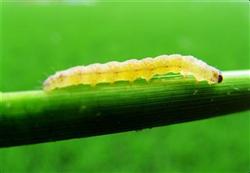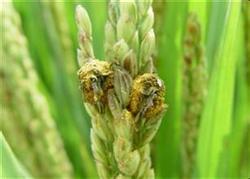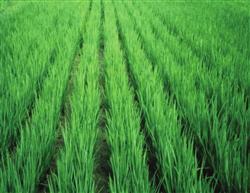Control techniques of common diseases and insect pests in rice

A bacterial disease in the leaves of rice. The pathogen is a pathogenic variety of rice yellow unicellular rice in prokaryotes. The bacteria are immersed in the wounds and pores of the roots, stems and leaves and multiply in the ducts of the vascular bundles. Seedling stage and tillering stage are the most vulnerable. Most of the seedling leaves showed the symptom of leaf withering. Most of the infected varieties showed acute wilting symptoms, the disease spots were bluish gray and waterlogged, the diseased leaves curled and withered rapidly, and brown spots appeared on the resistant varieties. The suitable temperature for the development of the pathogen was 26 ℃-30 ℃, and it overwintered on the diseased remains. Rice seeds could also carry bacteria and spread through wind and rain. Excessive nitrogen fertilizer and low-lying flooded fields developed early and seriously. After typhoon and rainstorm, the disease often spreads rapidly on the susceptible varieties. Control measures: selection of disease-resistant varieties, prevention of flooding in rice fields is the key to disease control, combined with chemical control. Rice evil seedling disease, also known as white stem disease, is a fungal disease of rice aboveground. The pathogen is Fusarium fujikura of ascomycete subphylum. The asexual state is Fusarium moniliforme, which is a subphylum of semi-unknown bacteria. The disease can occur from seedling stage to heading stage. The diseased plant is overgrown, thin, yellowed, usually 3-10 cm taller than the healthy plant, and is easy to identify. There are often inverted aerial roots and pink mildew layer on the basal nodes of diseased plants. The optimum temperature for the development of the pathogen was about 25 ℃, and the seeds carried the bacteria. Selecting disease-free seeds or soaking seeds with chemicals before sowing are the key measures for prevention and control. Rice sheath blight should be applied when the rate of diseased plants at booting stage reaches 30%-4% in diseased rice fields. The liquid should be sprayed on the middle and lower parts of the rice plant. Using the pouring method, the field should maintain a 3cm-5cm watering layer. When applying Jinggangmycin, it is best to do it on a sunny day after rain, or when there is no heavy rain within two hours after application. Use 5% of Jinggangmycin water 100 ml-150 ml, or 25 grams of Jinggangmycin high concentration powder, either spray 100 kg of water, or pour 400 kg of water. The rice borer should focus on the control of the second generation of Chilo suppressalis and the second and third generation of Chilo suppressalis in some areas, and focus on the rice fields from booting to full heading. You can also use 25% Insecticidal double Aqueous Agent 150ml-200ml, or 25% Insecticidal double Aqueous Agent 100ml plus BT Emulsion 100ml per mu, either by conventional spray of 60kg-75kg water or by low-dose spray of 5kg-7.5kg water. The rice planthopper should control the peak period of nymphs and apply pesticide when the number of nymphs per 100 clumps is more than 1500. When taking medicine, we should pay attention to start around the field and carry out encirclement and annihilation from the outside to the inside. Spray should be uniform and thoughtful, pay attention to spray the liquid in the middle and lower parts of the rice plant. Use 20-25 grams of prolactin wettable powder, or 20-25 grams of 25% Yuluode wettable powder, or 150 milliliters of 20% cicada powder EC, either, conventional spray of 75 kg-100 kg of water, or low-dose spray of 5 kg-7.5 kg of water. Rice bracts focus on late-middle rice fields, grasp the peak stage of low-instar larvae, and apply when there are 10-20 insects per 100 clumps of rice. Use 90% crystal trichlorfon 75g-100g per mu, or 50% fenitrothion EC 100ml-250ml, or BT emulsion 150ml-200ml, either by conventional spray of 75kg-100kg of water, or by low-dose spray of 5kg-7.5kg of water. The main damage generation of rice leaf roller is the key control. In the young larval stage, there were 15-20 buds per 100 clumps of rice, or 20 buds per 100 clumps at the panicle stage. Use 25% insecticidal double water agent 150 ml-200 ml, or 50% fenitrothion EC 72 ml, either conventional spray on 60 kg-72 kg of water, or low dose spray on 5 kg-7.5 kg of water. The appropriate time for application is in the evening. Vigorously popularize the new technology of using strychnine at panicle stage. In the booting stage of rice, 50-100g / mu of 15% vermicellin wettable powder can effectively prevent the premature senescence of hybrid rice and treat many kinds of panicle diseases such as rice sheath blight, rice false smut, rice grain smut and so on.
- Prev

What are the key points for the prevention and control of rice false smut?
Rice is susceptible to disease at heading and flowering stage, and the pathogen is harmful to some grains on the panicle. At the joint of Yinggu, the yellowish green block was exposed, gradually expanded, and finally wrapped in the whole glume shell, the shape was 4 times larger than that of healthy grain, it was dark green, the surface was smooth, then cracked, and dark green powder was scattered. The weather is closely related to the occurrence of false smut.
- Next

Zinc fertilizer for rice, disease resistance, high yield and health
Rice enters the jointing and panicle stage, which is not only an important period for the transformation from vegetative growth to reproductive growth, but also a key period to determine yield. To do a good job in the field management of rice in the middle and later stage is very important for protecting full panicle, attacking large panicle, shaping high-yield plant type and setting up high-yield shelf. First, the characteristics of seedling situation according to the survey on July 21.
Related
- The first cup of black tea in spring, the flavor and history of tea gardens in Kenya, Africa
- The computer can not only choose potatoes, but also grow tea rice. AI will grow winter oolong tea champion.
- It is not only the inflated tea bitten by insects, but also engraved with the four seasons tea in Beipu.
- The Oriental Beauty Tea Festival in Zhuxian County takes the stage at the weekend to experience the plus-size feast of oil tea.
- & quot; Oriental Beauty Tea & Exploration of Emei in Hsinchu, the hometown of quot;
- The new variety of strawberry "Tainong 1" dessert is the first choice with mellow aroma. Crimson gorgeous
- History of Tea in Taiwan: from Wild Inner Mountain to Export Tea Garden
- Two types of Taiwan Oriental Beauty Black Tea won the British three-Star Award for Childhood Tea Xiang Zhang Jiaqi changed from pilot to champion tea maker.
- Banana species and varieties: the planting history of Taiwan Xianren banana and dwarf banana is long, is banana disease resistant?
- Coffee planting Technology: Qianjie Coffee from Seedling to harvesting

